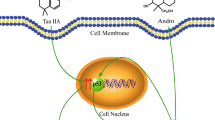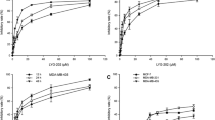Abstract
Resveratrol (RES) is a natural polyphenol having anti-proliferative activity against breast cancer cells. RES in combination with other chemo modulatory agents, minimizes toxicity and increases efficacy of the treatment. Salinomycin (SAL), a monocarboxylic polyether ionophore is known for selectively targeting breast cancer stem cells. Purpose of the present study was to investigate whether RES in combination with SAL exerts synergistic anti-proliferative activity on breast cancer cells. We further evaluated the molecular mechanism behind SAL and RES mediated cell death. Cytotoxicity assay was performed to determine 50% inhibitory concentration (IC50) of SAL and RES in different human breast cancer cells (HBCCs). Drug synergism and combination index (CI) were calculated using CompuSyn software and effects of synergistic combinations (CI < 1) involving lower doses of SAL and RES were selected for further studies. This combination significantly induced apoptosis in HBCCs without affecting non tumorigenic human breast epithelial cells MCF-10A. Co-treatment enhanced apoptosis in MCF-7 cells via reactive oxygen species (ROS) mediated mitochondrial dysfunction. Oxidative stress disrupt redox homeostasis which altered antioxidant enzymes viz. CuZn Superoxide dismutase (SOD), MnSOD and catalase. Additionally, combination altered nuclear morphology, enhanced PARP cleavage and led to caspase activation. SAL and RES also synergistically modulated MAPK pathway. Study suggests that SAL and RES offer a novel combination approach for the treatment of breast cancer.







Similar content being viewed by others
References
Torre LA, Bray F, Siegel RL, Ferlay J, Lortet-Tieulent J, Jemal A (2015) Global cancer statistics, 2012. CA Cancer J Clin 65:87–108
Carter LG, D’Orazio JA, Pearson KJ. (2014) Resveratrol and cancer: focus on in vivo evidence. Endocr Related Cancer 21:R209–R225
Tinoco G, Warsch S, Gluck S, Avancha K, Montero AJ (2013) Treating breast cancer in the 21st century: emerging biological therapies. J Cancer 4:117–132
Higgins MJ, Baselga J (2011) Targeted therapies for breast cancer. J Clin Invest 121:3797–3803
Gottesman MM, Pastan I (1993) Biochemistry of multidrug resistance mediated by the multidrug transporter. Annu Rev Biochem 62:385–427
Suntharalingam K, Lin W, Johnstone TC et al (2014) A breast cancer stem cell-selective, mammospheres-potent osmium(VI) nitrido complex. J Am Chem Soc 136:14413–14416
Chen LS, Wang AX, Dong B, Pu KF, Yuan LH, Zhu YM (2012) A new prospect in cancer therapy: targeting cancer stem cells to eradicate cancer. Chinese. J Cancer 31:564–572
Jangamreddy JR, Ghavami S, Grabarek J et al (2013) Salinomycin induces activation of autophagy, mitophagy and affects mitochondrial polarity: differences between primary and cancer cells. Biochim Biophys Acta 1833:2057–2069
Fuchs D, Heinold A, Opelz G, Daniel V, Naujokat C (2009) Salinomycin induces apoptosis and overcomes apoptosis resistance in human cancer cells. Biochem Biophys Res Commun 390:743–749
Huczynski A, Janczak J, Antoszczak M, Wietrzyk J, Maj E, Brzezinski B (2012) Antiproliferative activity of salinomycin and its derivatives. Bioorg Med Chem Lett 22:7146–7150
Ketola K, Hilvo M, Hyotylainen T et al (2012) Salinomycin inhibits prostate cancer growth and migration via induction of oxidative stress. Br J Cancer 106:99–106
Wang F, He L, Dai WQ et al (2012) Salinomycin inhibits proliferation and induces apoptosis of human hepatocellular carcinoma cells in vitro and in vivo. PLoS ONE 7:e50638
Zhou S, Wang F, Wong ET et al (2013) Salinomycin: a novel anti-cancer agent with known anti-coccidial activities. Curr Med Chem 20:4095–4101
Gupta PB, Onder TT, Jiang G et al (2009) Identification of selective inhibitors of cancer stem cells by high-throughput screening. Cell 138:645–659
Dewangan J, Srivastava S, Rath SK (2017) Salinomycin: a new paradigm in cancer therapy. Tumour Biol 39:1010428317695035
Ojo OO, Bhadauria S, Rath SK (2013) Dose-dependent adverse effects of salinomycin on male reproductive organs and fertility in mice. PLoS ONE 8:e69086
Aleman M, Magdesian KG, Peterson TS, Galey FD (2007) Salinomycin toxicosis in horses. J Am Vet Med Assoc 230:1822–1826
Sinha D, Sarkar N, Biswas J, Bishayee A. (2016) Resveratrol for breast cancer prevention and therapy: preclinical evidence and molecular mechanisms. Seminars in cancer biology. Academic Press, Cambridge
Fremont L (2000) Biological effects of resveratrol. Life Sci 66:663–673
Baur JA, Sinclair DA. (2006) Therapeutic potential of resveratrol: the in vivo evidence. Nat Rev Drug Discov 5:493–506
Shi J, Zeng Q, Liu Y, Pan Z (2012) Alternaria sp. MG1, a resveratrol-producing fungus: isolation, identification, and optimal cultivation conditions for resveratrol production. Appl Microbiol Biotechnol 95:369–379
Subbaramaiah K, Chung WJ, Michaluart P et al (1998) Resveratrol inhibits cyclooxygenase-2 transcription and activity in phorbol ester-treated human mammary epithelial cells. J Biol Chem 273:21875–21882
Le Corre L, Chalabi N, Delort L, Bignon YJ, Bernard-Gallon DJ. (2005) Resveratrol and breast cancer chemoprevention: molecular mechanisms. Molecular Nutr Food Res 49:462–471
Gupta SC, Kannappan R, Reuter S, Kim JH, Aggarwal BB (2011) Chemosensitization of tumors by resveratrol. Ann N Y Acad Sci 1215:150–160
Chou TC (2006) Theoretical basis, experimental design, and computerized simulation of synergism and antagonism in drug combination studies. Pharmacol Rev 58:621–681
Holliday DL, Speirs V. (2011) Choosing the right cell line for breast cancer research. Breast Cancer Res 13:215
Chou TC, Talalay P (1981) Generalized equations for the analysis of inhibitions of Michaelis–Menten and higher-order kinetic systems with two or more mutually exclusive and nonexclusive inhibitors. European journal of biochemistry/FEBS 115:207–216
Chou TC, Talalay P (1984) Quantitative analysis of dose-effect relationships: the combined effects of multiple drugs or enzyme inhibitors. Adv Enzyme Regul 22:27–55
Chou TC (2010) Drug combination studies and their synergy quantification using the Chou–Talalay method. Cancer Res 70:440–446
Saraste A, Pulkki K (2000) Morphologic and biochemical hallmarks of apoptosis. Cardiovasc Res 45:528–537
Vermes I, Haanen C, Steffens-Nakken H, Reutelingsperger C (1995) A novel assay for apoptosis. Flow cytometric detection of phosphatidylserine expression on early apoptotic cells using fluorescein labelled Annexin V. J Immunol Methods 184:39–51
Michaeloudes C, Sukkar MB, Khorasani NM, Bhavsar PK, Chung KF (2011) TGF-beta regulates Nox4, MnSOD and catalase expression, and IL-6 release in airway smooth muscle cells. Am J Physiol Lung Cell Mol Physiol 300:L295–L304
Baluchamy S, Ravichandran P, Ramesh V et al (2012) Reactive oxygen species mediated tissue damage in high energy proton irradiated mouse brain. Mol Cell Biochem 360:189–195
Kim SJ, Jung HJ, Lim CJ (2011) Disruption of redox homeostasis and induction of apoptosis by suppression of glutathione synthetase expression in a mammalian cell line. Free Radic Res 45:1040–1051
Schrader M, Fahimi HD (2006) Peroxisomes and oxidative stress. Biochim Biophys Acta 1763:1755–1766
Patrushev N, Seidel-Rogol B, Salazar G (2012) Angiotensin II requires zinc and downregulation of the zinc transporters ZnT3 and ZnT10 to induce senescence of vascular smooth muscle cells. PLoS ONE 7:e33211
Chau LY (2015) Heme oxygenase-1: emerging target of cancer therapy. J Biomed Sci 22:22
Verdoodt B, Vogt M, Schmitz I, Liffers ST, Tannapfel A, Mirmohammadsadegh A (2012) Salinomycin induces autophagy in colon and breast cancer cells with concomitant generation of reactive oxygen species. PLoS ONE 7:e44132
Kumar S (2007) Caspase function in programmed cell death. Cell Death Differ 14:32–43
McIlwain DR, Berger T, Mak TW. (2013) Caspase functions in cell death and disease. Cold Spring Harbor Perspect Biol 5:a008656
Huang WR, Zhang Y, Tang X (2014) Shikonin inhibits the proliferation of human lens epithelial cells by inducing apoptosis through ROS and caspase-dependent pathway. Molecules 19:7785–7797
Germain M, Affar EB, D’Amours D, Dixit VM, Salvesen GS, Poirier GG (1999) Cleavage of automodified poly(ADP-ribose) polymerase during apoptosis. Evidence for involvement of caspase-7. J Biol Chem 274:28379–28384
Son Y, Cheong YK, Kim NH, Chung HT, Kang DG, Pae HO (2011) Mitogen-activated protein kinases and reactive oxygen species: how can ROS activate MAPK pathways? J Signal Transduct 2011:792639
Acknowledgements
This work was supported by grants from Council of Scientific and Industrial Research, networking project BSC0103. J.D. gratefully acknowledge the fellowship received from University Grant Commission, New Delhi, A.K.V. and D.T. acknowledge the fellowship received from Council of Scientific and Industrial Research, S.S. acknowledge the fellowship received from Indian Council of Medical Research. Authors want to acknowledge Mr. A.L. Vishwakarma for support in flow cytometric studies. We are greatly thankful to Dr. Sharad Sharma for his valuable help in English editing of this manuscript. CSIR-CDRI communication number for this manuscript is 9514.
Author information
Authors and Affiliations
Contributions
JD and SKR designed study, analysed data and prepared draft of manuscript. JD, DT, AY performed experimental work. SS and AKV helped in flow cytometer and data interpretation. All authors reviewed the manuscript.
Corresponding author
Ethics declarations
Conflict of interest
The authors declare no competing financial interests.
Electronic supplementary material
Below is the link to the electronic supplementary material.
Rights and permissions
About this article
Cite this article
Dewangan, J., Tandon, D., Srivastava, S. et al. Novel combination of salinomycin and resveratrol synergistically enhances the anti-proliferative and pro-apoptotic effects on human breast cancer cells. Apoptosis 22, 1246–1259 (2017). https://doi.org/10.1007/s10495-017-1394-y
Published:
Issue Date:
DOI: https://doi.org/10.1007/s10495-017-1394-y




